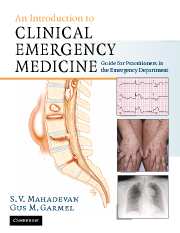Book contents
- Frontmatter
- Contents
- List of contributors
- Foreword
- Acknowledgments
- Dedication
- Section 1 Principles of Emergency Medicine
- 1 Approach to the emergency patient
- 2 Airway management
- 3 Cardiopulmonary and cerebral resuscitation
- 4 Cardiac dysrhythmias
- 5 Shock
- 6 Traumatic injuries
- 7 Prehospital care and emergency medical services
- 8 Pain management
- Section 2 Primary Complaints
- Section 3 Unique Issues in Emergency Medicine
- Section 4 Appendices
- Index
7 - Prehospital care and emergency medical services
Published online by Cambridge University Press: 27 October 2009
- Frontmatter
- Contents
- List of contributors
- Foreword
- Acknowledgments
- Dedication
- Section 1 Principles of Emergency Medicine
- 1 Approach to the emergency patient
- 2 Airway management
- 3 Cardiopulmonary and cerebral resuscitation
- 4 Cardiac dysrhythmias
- 5 Shock
- 6 Traumatic injuries
- 7 Prehospital care and emergency medical services
- 8 Pain management
- Section 2 Primary Complaints
- Section 3 Unique Issues in Emergency Medicine
- Section 4 Appendices
- Index
Summary
History of emergency medical services
Over the past four decades, prehospital care and emergency medical services (EMS) in the US have evolved rapidly from near nonexistence into key links in the chain of survival for patients with acute injury or illness. Beginning in the mid-1960s, after a landmark report titled Accidental Death and Disability: The Neglected Disease of Modern Society detailed serious deficiencies in out-of-hospital trauma management, state and federal lawmakers began to enact new standards for training, equipment, and oversight in EMS systems. The resulting translation into the field of formerly hospital-limited therapies for life threats, such as the unstable airway, respiratory failure, hemodynamic collapse, and dysrhythmias, in addition to traumatic injuries, has resulted in countless numbers of lives saved. With further advances in research, technology, and education, today's prehospital care providers are continually becoming more sophisticated in the diagnosis and treatment of acute injury and illness. Understanding the structure and capabilities of EMS is a critical component of emergency medicine, as the collaboration between prehospital and hospital-based providers determines the quality of emergency medical care delivered to the community.
Prehospital systems
Each municipality or rural area has several options with regard to the administration of their EMS. When government-run, EMS can be administered either as a stand-alone agency or under the command of the fire department. Alternatively, prehospital care can be provided by a local hospital or private ambulance company under contract to the city or county.
- Type
- Chapter
- Information
- An Introduction to Clinical Emergency MedicineGuide for Practitioners in the Emergency Department, pp. 117 - 130Publisher: Cambridge University PressPrint publication year: 2005

